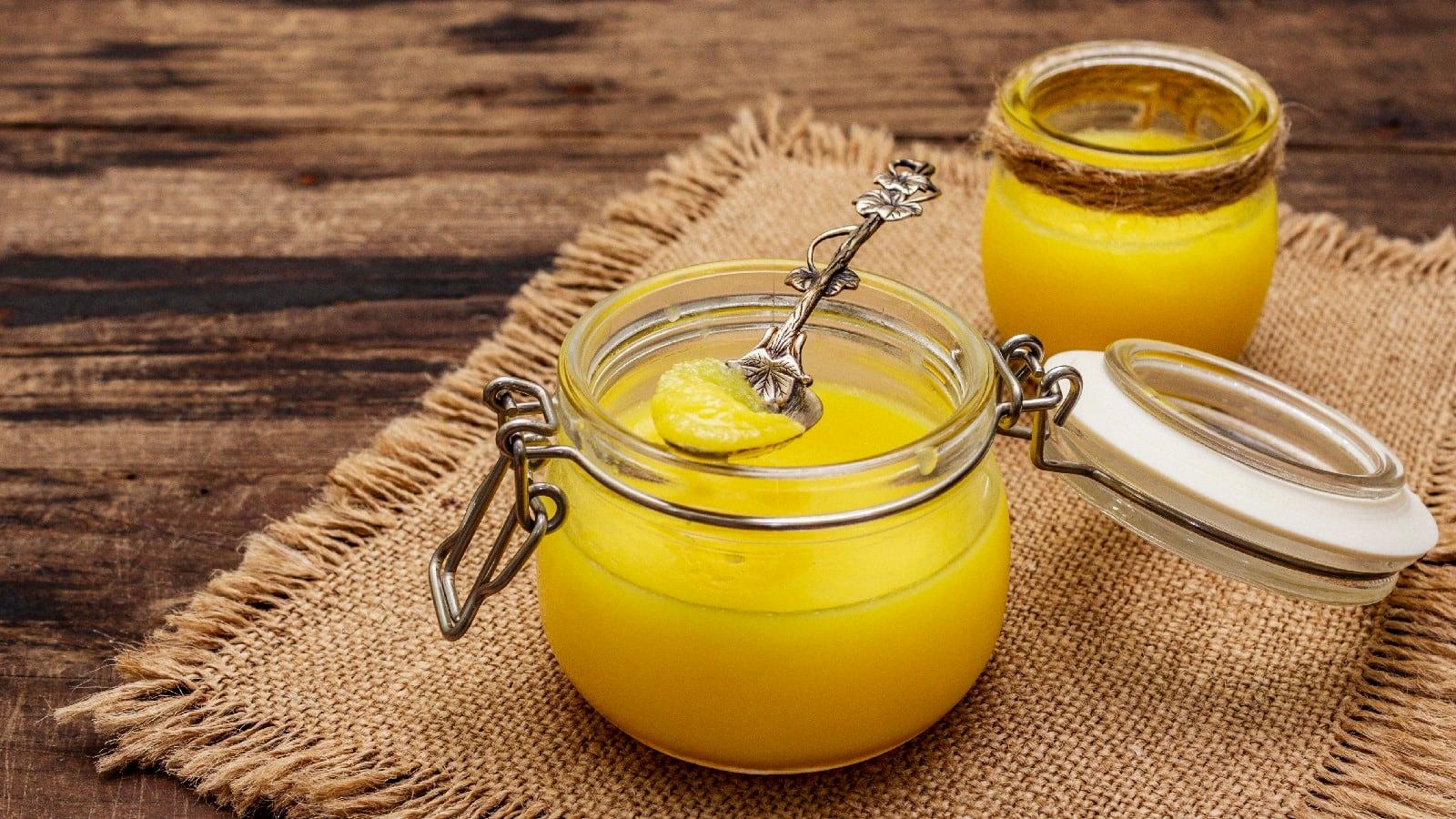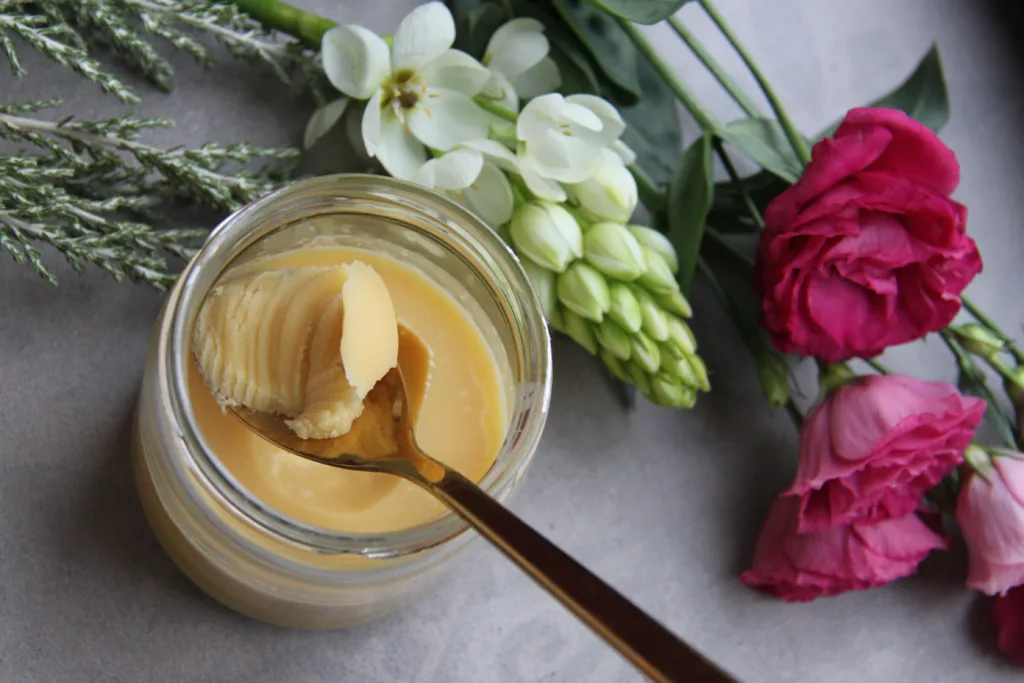Ghee is a type of clarified butter that has been used for centuries in the Indian subcontinent and Southeast Asia. It is made by simmering unsalted butter until the water and milk solids are removed, leaving behind pure butterfat. Ghee has a high smoke point, making it a popular cooking fat for frying and sautéing.
One of the most significant advantages of ghee is its exceptional shelf life. Because it contains no water, bacteria cannot grow in it, making it incredibly stable. This means that ghee can be stored for extended periods of time without spoiling, even at room temperature.
An unopened jar of ghee can be stored in a cool, dark place, away from direct sunlight, for up to nine months without any concern. Once opened, the ghee can be kept in a kitchen cabinet at room temperature for up to six months or in the refrigerator for up to a year.
Storing ghee at room temperature is the easiest and most convenient option, as it does not require any special precautions. However, to ensure that the ghee stays fresh, it is essential to keep the jar free from moisture and steam. Therefore it is advisable to keep the jar away from the steaming stovetop.
If you want to extend the shelf life of your ghee, you can store it in the refrigerator. However, it is essential to keep in mind that ghee can become hard and difficult to scoop when refrigerated. Therefore, it is best to take the ghee out of the fridge a few minutes before using it to alow it to soften.
Ghee is an incredibly stable and long-lasting cooking fat that can be stored at room temperature for extended periods of time. As long as the jar is kept free from moisture and steam, ghee can last for up to six months in a kitchen cabinet or up to a year in the refrigerator. So, if you have a jar of ghee in your pantry, rest assured that it is likely still fresh and ready to use, even if you haven’t used it in a while.
Identifying Signs That Ghee Has Gone Bad
Ghee is a type of clarified butter that is commonly used in Indian cuisine. It has a long shelf life due to its low moisture content and high fat content. However, like any other food item, ghee can go bad over time. Here are some signs to look out for to determine if your ghee has gone bad:
1. Mold or discoloration: If you notice any mold or discoloration on your ghee, it has gone bad and should not be consumed.
2. Sour flavor and unpleasant odor: Rancid ghee has a sour flavor and an unpleasant odor that is quite noticeable. If your ghee smells off, it is best to discard it.
3. White appearance: Ghee is typically yellow in color. If your ghee appears white, it may be an indication that it has gone bad.
It is essential to store ghee properly to extend its shelf life. Keep it in an airtight container away from direct sunlight and moisture. Avoid usig a wet spoon or utensil to scoop out ghee, as it can introduce moisture and bacteria into the container.
Always check for mold or discoloration, sour flavor and odor, and white appearance before using ghee to ensure that it has not gone bad.

Source: healthshots.com
Consequences of Not Refrigerating Ghee
Ghee is a type of clarified butter that is commonly used in Indian cuisine. One of the unique characteristics of ghee is that it is extremely shelf-stable, which means that it does not require refrigeration to remain safe for consumption.
This is because ghee contais no water, which is a key factor in the growth of bacteria. Without water, bacteria cannot thrive, which means that ghee will not spoil in the same way that other dairy products might.
However, it is important to note that the quality of ghee can be affected by exposure to heat, light, and air. To keep ghee shelf-stable, it is important to store it in a cool, dark place away from direct sunlight and heat sources.
In addition, it is important to make sure that the jar of ghee remains both water and steam-free. This means avoiding placing it near a steaming stovetop, for example, as moisture can compromise the quality of the ghee.
Ghee is an incredibly versatile and shelf-stable ingredient that can be used in a variety of recipes. By following these simple storage guidelines, you can ensure that your ghee remains fresh and safe for consumption for an extended period of time.
How Long Does Opened Ghee Last?
Ghee, also known as clarified butter, is a popular ingredient in many Indian and South Asian dishes. It has a long shelf life, but once opened, it is important to store it properly to ensure its quality and safety for consumption.
After opening, ghee can be stored in a cool, dry place at room temperature for up to six months. However, if you live in a hot and humid climate, it is best to store it in the refrigerator to prevent spoilage.
If you choose to store ghee in the refrigerator, it can last up to a year. It is important to keep the jar tightly sealed to prevent moisture and contaminants from entering the container.
To ensure the quality of the ghee, it is recommended to check for any signs of spoilage before using it. If the ghee has a rancid smell or taste or has developed mold, it shoud be discarded immediately.
Ghee can last up to six months at room temperature after opening and up to a year in the refrigerator. Proper storage techniques and regular checks for spoilage can help ensure the safety and quality of the ghee.
Storing Ghee Without a Refrigerator
Ghee is a popular ingredient in Indian and Middle Eastern cuisine and is widely used for cooking and baking. It is a form of clarified butter that has been simmered to remove impurities, resulting in a rich, nutty flavor and a high smoke point. One of the most common questions about ghee is whether it can be stored without refrigeration.
The good news is that ghee can be kept at room temperature and does not require refrigeration. This is because the process of making ghee involves removing all of the moisture and milk solids, which are the elements that cause butter to spoil. As a result, ghee has a longer shelf life than regular butter and can be stored for several months without going bad.
However, it is important to store ghee properly to ensure its freshness and quality. Here are some tips for storing ghee at room temperature:
1. Keep it in an airtight container: Ghee shuld be stored in a tightly sealed container to prevent air and moisture from getting in. This will help to maintain its flavor and texture.
2. Store it in a cool, dark place: Ghee should be kept away from direct sunlight and heat, as this can cause it to spoil more quickly. A pantry or cupboard is a good place to store ghee.
3. Use a clean spoon: When using ghee, always use a clean spoon to avoid introducing bacteria into the container. This will help to prevent contamination and extend the shelf life of the ghee.
4. Check for signs of spoilage: Although ghee can be stored at room temperature, it is still important to check it regularly for signs of spoilage. If it develops an off smell or taste, or if you see mold or discoloration, it should be discarded.
Ghee can be stored without refrigeration at room temperature for several months if it is stored properly. By keeping it in an airtight container, in a cool, dark place, and using a clean spoon, you can enjoy the rich flavor and benefits of ghee for a long time.

Conclusion
Ghee is a highly versatile and nutritious ingredient that can greatly enhance the flavor and health benefits of your meals. However, it is important to always check for signs of rancidity before using it, as it can spoil over time if exposed to moisture, heat, light, or air. With proper storage in a cool, dry, and dark place, or in the refrigerator, ghee can remain fresh and shelf-stable for up to a year. Whether you are cooking, baking, or simply spreading it on toast, ghee can be a delicious and healthy addition to your diet. So next time you reach for the butter, consier giving ghee a try and experience the many benefits it has to offer.
